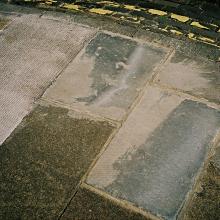
If you happened across something like this on your street, you'd possibly assume someone had been sick and step around it.
You probably wouldn't expect to find another example around the corner, and would certainly be surprised to discover it was the work of Council contractors. Each instance was accompanied by a sign proclaiming, optimistically, 'Investing in your neighbourhood'.
Imagine, then, how New Town residents felt when they kept discovering instances of slap-dash pavement repairs across the Edinburgh World Heritage Site in recent weeks. All our photos come from India Street, but there are other examples on Gloucester Place, Heriot Row and Doune Terrace, to name but a few.
[img_assist|nid=3500|title=|desc=|link=node|align=right|width=134|height=200]The works had been carried out as part of City of Edinburgh's new Right First Time programme, in which minor road and pavement defects are being targeted and permanently repaired across the city.
Acting in a private capacity, one of the affronted locals – David Jackson Young – complained to the Council, and was told in a polite letter from a Road Services Consultant for the City Centre and Leith that the unsightly pre-cast concrete slabs would weather to match their surrounds, and that staining due to lime in the cement could be removed using an acid wash later.
He insisted that, having personally visited the area, he was satisfied that the work had been 'carried out to the high standards expected of all our contractors'.
Young was not pleased. He felt that in so enthusiastically defending this 'abysmal workmanship', the official in question was simply arguing that black is white. 'It is, he told Spurtle, 'another alarming instance of the yawning gap between the Council's supposed "aspirations" – as expressed in lofty-sounding documents like the 'Edinburgh Standards for Streets' – and what actually happens on the ground'.
[img_assist|nid=3501|title=|desc=|link=node|align=right|width=200|height=134]Young wrote to the official again, who later replied acknowledging that 'there are signs of cement staining and areas of "blooming" still evident, but these are considered to be of such a minor nature that further works, such as an acid wash, would not be beneficial ... It is our intention to allow the natural weathering process to blend the new slabs with their surrounds and that will ultimately provide the desired effect.'
Still less than cheery, Young had by now approached City Centre ward councillor Joanna Mowat, who had begun tactfully rattling cages in East Market Street. Spurtle understands she received an apology from Services for Communities director Mark Turley's office for the initial 'unacceptable response', and an assurance that three of the worst examples would be cleaned up by 26 October at the latest. As of yesterday, nothing had been done.
[img_assist|nid=3502|title=|desc=|link=node|align=right|width=200|height=134]Young regards cleaning up just the three worst instances as a token gesture. 'It seems to me,' he tells Spurtle, 'that a more honest initial response from the Council would have been: "Yes, our pavement upgrade programme has made your street look bloody awful. But we don't have the money or resources to put it right, and in fact we don't have enough skilled workers to do the job properly in the first place. (So there's not really much point in sending someone in a suit from the office to monitor the work anyway.) Too bad, mate, but there it is."'
The cases described here are of particular note because they occurred in part of the UNESCO Edinburgh World Heritage Site, but we have reports of similar examples across Stockbridge and Leith Walk. Is decent – or at least neat – workmanship a thing of the past?
Let us know how well or badly the pavements have been repaired in your part of Greater Spurtleshire.
[img_assist|nid=3505|title=|desc=|link=node|align=middle|width=640|height=429]